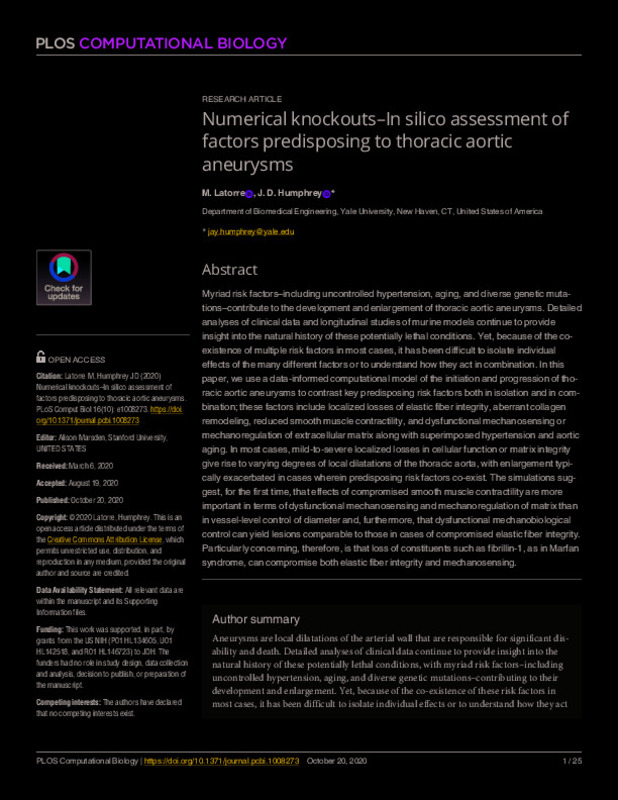JavaScript is disabled for your browser. Some features of this site may not work without it.
Buscar en RiuNet
Listar
Mi cuenta
Estadísticas
Ayuda RiuNet
Admin. UPV
Numerical knockouts-In silico assessment of factors predisposing to thoracic aortic aneurysms
Mostrar el registro sencillo del ítem
Ficheros en el ítem
| dc.contributor.author | Latorre, Marcos
|
es_ES |
| dc.contributor.author | Humphrey, Jay D.
|
es_ES |
| dc.date.accessioned | 2023-01-30T19:01:07Z | |
| dc.date.available | 2023-01-30T19:01:07Z | |
| dc.date.issued | 2020-10-20 | es_ES |
| dc.identifier.issn | 1553-734X | es_ES |
| dc.identifier.uri | http://hdl.handle.net/10251/191512 | |
| dc.description.abstract | [EN] Myriad risk factors-including uncontrolled hypertension, aging, and diverse genetic mutations-contribute to the development and enlargement of thoracic aortic aneurysms. Detailed analyses of clinical data and longitudinal studies of murine models continue to provide insight into the natural history of these potentially lethal conditions. Yet, because of the co-existence of multiple risk factors in most cases, it has been difficult to isolate individual effects of the many different factors or to understand how they act in combination. In this paper, we use a data-informed computational model of the initiation and progression of thoracic aortic aneurysms to contrast key predisposing risk factors both in isolation and in combination; these factors include localized losses of elastic fiber integrity, aberrant collagen remodeling, reduced smooth muscle contractility, and dysfunctional mechanosensing or mechanoregulation of extracellular matrix along with superimposed hypertension and aortic aging. In most cases, mild-to-severe localized losses in cellular function or matrix integrity give rise to varying degrees of local dilatations of the thoracic aorta, with enlargement typically exacerbated in cases wherein predisposing risk factors co-exist. The simulations suggest, for the first time, that effects of compromised smooth muscle contractility are more important in terms of dysfunctional mechanosensing and mechanoregulation of matrix than in vessel-level control of diameter and, furthermore, that dysfunctional mechanobiological control can yield lesions comparable to those in cases of compromised elastic fiber integrity. Particularly concerning, therefore, is that loss of constituents such as fibrillin-1, as in Marfan syndrome, can compromise both elastic fiber integrity and mechanosensing. Author summary Aneurysms are local dilatations of the arterial wall that are responsible for significant disability and death. Detailed analyses of clinical data continue to provide insight into the natural history of these potentially lethal conditions, with myriad risk factors-including uncontrolled hypertension, aging, and diverse genetic mutations-contributing to their development and enlargement. Yet, because of the co-existence of these risk factors in most cases, it has been difficult to isolate individual effects or to understand how they act in combination. In this paper, we use a computational model of the initiation and progression of thoracic aortic aneurysms to contrast key predisposing factors both in isolation and in combination as well as with superimposed hypertension and aging. The present study recovers many findings from mouse models but with new and important observations that promise to guide in vivo and ex vivo studies as we seek to understand and eventually better treat these complex, multi-factorial lesions, with data-informed patient-specific computations eventually the way forward. | es_ES |
| dc.description.sponsorship | This work was supported, in part, by grants from the US NIH (P01 HL134605, U01 HL142518, and R01 HL146723) to JDH. The funders had no role in study design, data collection and analysis, decision to publish, or preparation of the manuscript. | es_ES |
| dc.language | Inglés | es_ES |
| dc.publisher | Public Library of Science | es_ES |
| dc.relation.ispartof | PLoS Computational Biology | es_ES |
| dc.rights | Reserva de todos los derechos | es_ES |
| dc.subject | Collagens | es_ES |
| dc.subject | Smooth muscles | es_ES |
| dc.subject | Aorta | es_ES |
| dc.subject | Muscle contraction | es_ES |
| dc.subject | Mouse models | es_ES |
| dc.subject | Aneurysms | es_ES |
| dc.subject | Hypertension | es_ES |
| dc.subject | Stiffness | es_ES |
| dc.title | Numerical knockouts-In silico assessment of factors predisposing to thoracic aortic aneurysms | es_ES |
| dc.type | Artículo | es_ES |
| dc.identifier.doi | 10.1371/journal.pcbi.1008273 | es_ES |
| dc.relation.projectID | info:eu-repo/grantAgreement/NIH//P01 HL134605 //Endothelial Mechanotransduction in Thoracic Aneurysm Formation and Progression/ | es_ES |
| dc.relation.projectID | info:eu-repo/grantAgreement/NIH//U01 HL142518//Multimodality imaging-driven multifidelity modeling of aortic dissection/ | es_ES |
| dc.relation.projectID | info:eu-repo/grantAgreement/NIH//R01 HL146723//Smooth Muscle Cell Proliferation and Degradative Phenotype in Thoracic Aorta Aneurysm and Dissection/ | es_ES |
| dc.rights.accessRights | Abierto | es_ES |
| dc.description.bibliographicCitation | Latorre, M.; Humphrey, JD. (2020). Numerical knockouts-In silico assessment of factors predisposing to thoracic aortic aneurysms. PLoS Computational Biology. 16(10):1-38. https://doi.org/10.1371/journal.pcbi.1008273 | es_ES |
| dc.description.accrualMethod | S | es_ES |
| dc.relation.publisherversion | https://doi.org/10.1371/journal.pcbi.1008273 | es_ES |
| dc.description.upvformatpinicio | 1 | es_ES |
| dc.description.upvformatpfin | 38 | es_ES |
| dc.type.version | info:eu-repo/semantics/publishedVersion | es_ES |
| dc.description.volume | 16 | es_ES |
| dc.description.issue | 10 | es_ES |
| dc.identifier.pmid | 33079926 | es_ES |
| dc.identifier.pmcid | PMC7598929 | es_ES |
| dc.relation.pasarela | S\472452 | es_ES |
| dc.contributor.funder | National Institutes of Health, EEUU | es_ES |
| dc.subject.ods | 03.- Garantizar una vida saludable y promover el bienestar para todos y todas en todas las edades | es_ES |








